SDSU football begins winter conditioning under Jeff Sobol
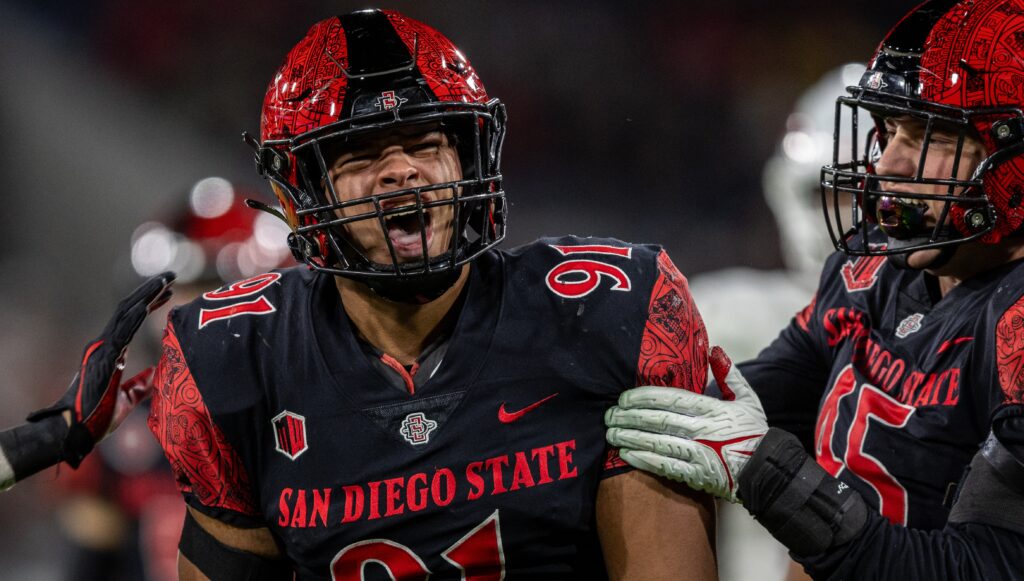
Keion Mitchell celebrates a sack against Fresno State. (PJ Panebianco/EVT)
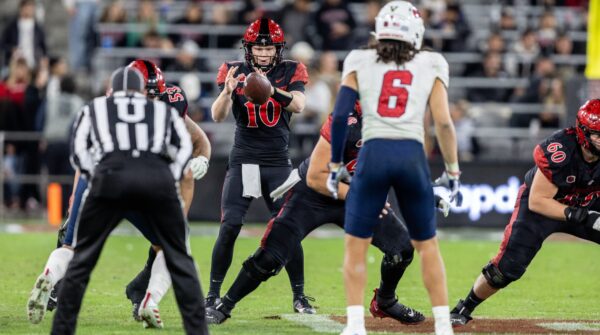
San Diego State football begins its first winter conditioning under new head coach Sean Lewis with a team meeting today that will lay out the expectations for this phase of the program’s calendar.
Tomorrow, the team will report to the weight room. For roughly eight weeks, the players will enter new Head of Football Performance Jeff Sobol’s boot camp for their first direct training into Lewis’ Aztec Fast philosophy.
During this critical period, SDSU’s athletes will work through a grueling crucible off the field meant to shape them to compete on it. Spring Camp should begin the week of March 10th and culminate with a scrimmage the weekend of April 20.
“It’s definitely a step-by-step process,” Sobol explained. “And the cool thing about strength is there’s a million ways to do it. We all have the end goal of putting the best product on the field in the Fall that we possibly can. Having every player that we have be at their best.”
Below are four keys to a successful winter conditioning program for the Aztecs.
The quotes from Sobol throughout the article were used with permission by the We Believe Network, which is part of the Aztec Link NIL collective.
On Monday night, they hosted Sobol on their “We Believe Coaches Show.” Subscribers to the NIL collective, which start at $6.99 a month, have access to exclusive events like Sobol’s interview.
Jeff Sobol winning the hearts and minds of his players
When Lewis announced the first incoming wave of Aztecs to the roster, he spoke directly about offensive lineman Nate Williams. Williams, Lewis explained, transferred in from Akron, where he trained under Sobol. Like a tiny amount of yeast that leavens the whole dough, Lewis hopes Williams’ successful experience under Sobol will spread to the entire team.
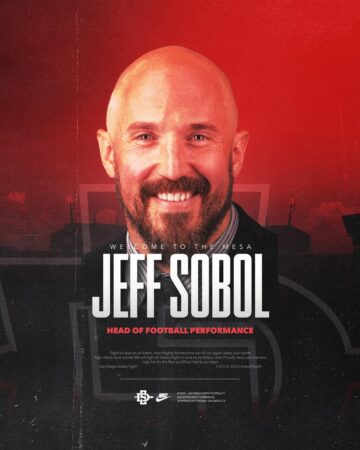
While it is assumed every Aztec is going into winter conditioning with the right attitude and belief to accept what Sobol is teaching, part of the purpose of such challenging regiments is to expose physical and mental weaknesses. Sobol’s tall task is to turn the faith the players currently have into confidence in his designs because they see the fruits of his training. If he is unable to hit the right note, doubt, which always accompanies faith, will creep in and threaten to derail what Lewis is building.
Sobol is inheriting a successful strength and conditioning program from his predecessor, Adam Hall. The positives of that fact is SDSU’s current staff has a great foundation on which to build. The negatives for Sobol is he has to deliver and prove to be at least as competent as Hall in the eyes of the holdovers on the roster.
“Everything starts from a simplistic standpoint because the simplest way is always the best way when it comes to programming,” Sobol said. “I’m not going to put a bunch of fluff in, but simple doesn’t mean easy. It just means we’re going to do the simple things at an elite level with really high intent.”
Denying human nature and moving past conventional limits is the point of strict discipline. Williams knows Sobol’s methods work to create better football players. It is critical that Sobol rewards the belief the rest of the team currently has in him with a successful winter conditioning experience.
Team chemistry
Chemistry is created through shared experiences. With the transfer portal making player movement more common, the importance of winter conditioning in bringing a team together increases. Many of the athletes who played critical roles for the Aztecs in 2023 are gone. Conversely, a large number of players not on the roster last year are expected to form the core of the team this season.
This combination diminishes the importance of last season as far chemistry is concerned. In most sports, offseason work is mostly individual, where athletes pursue growth by pushing past their individual boundaries. For SDSU’s winter conditioning to have its fullest effect, fostering a communal element to the process in addition to competition is critical.
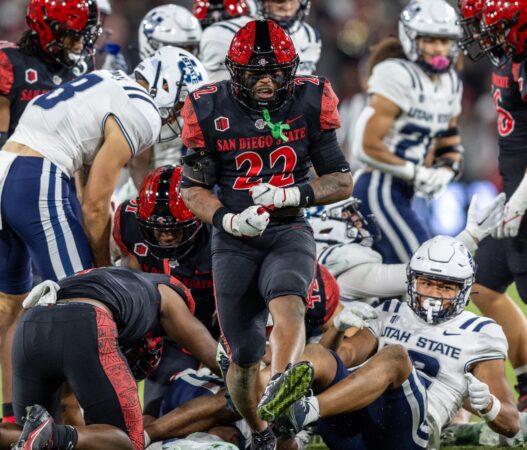
The model for this type of training that promotes trust and teamwork while pushing individuals past their limits is the BUD/S training Navy Seals receive locally in Coronado. Successful completion requires working together. Those who finish the grueling training typically form unshakeable bonds with their classmates.
While Sobol and SDSU should not be held to the standard set by the military’s Special Forces, the philosophy of his program should more resemble BUD/S than offseason training from the professional football ranks. In the latter, competition is the catalyst for individual growth. Competitive collaboration as the only path to success is the emphasis of the former.
“From a philosophy standpoint, I can do anything I want to in that weight room down there,” Sobol explained. “It’s huge and has all kinds of space. If I can’t get the job done in that room, I shouldn’t be at this place. I shouldn’t be in this role.”
As college football teams adjust to the realities of the transfer portal, the importance of year-round chemistry development is heightened. Whether through the intentions of Sobol’s designs or the character of the leaders on the team, building chemistry now will pay off in the fall.
Learning Aztec Fast
The beauty of college football is the varying approaches teams take to achieve success. Coaching staffs across the country create systems that best fits their specific institution’s constraints. Aztec Fast is Lewis’ attempt at building a championship level program at SDSU. It varies enough from Brady Hoke’s ideas of success that the first offseason will be needed to mold players into the types Lewis needs to succeed.
Speed, as the name indicates, is of primary importance to how Lewis wants SDSU to play. Under Hoke, practices were designed at a pace to maximize reps, so it will be interesting to see in spring camp how different Lewis’ dress rehearsals are. For now, the aspects of Aztec Fast that Sobol can work on is preparing them for the relentlessness of snapping the ball quick and the endurance needed on both sides of the ball that the tactic demands.
If SDSU’s offense is clicking, the same athletes will be running plays all over the field in varying formations without substituting. Defensively, the team will be expected to stop game plans that focus on ball control. The opposition will look to wear down the Aztec defense.
Building the physical reserves to face these challenges starts now. Football for SDSU is no longer a series of sprints with a huddle in between. They now compete at a break-neck pace that, at its best, only pauses in the end zone. Sobol said this first phase of training will emphasize on gaining strength and rebuilding what was lost over a grueling 2023 season. After spring, endurance will become a focus.
Developing successful habits
Preparing for the physical demands of Lewis’ system requires complete commitment. Athletes are more susceptible to cramping due to the required tempo. Drinking a gallon of water every day helps mitigate the impact. Those who do not dedicate themselves to this life altering task will be easy to spot because their muscles will be in knots on the sideline.
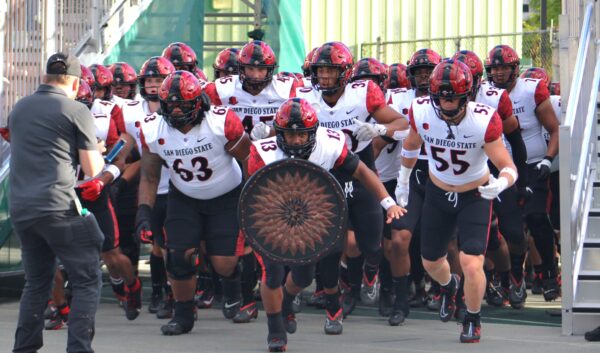
While the playbook will not be fully laid out until fall camp, the players will be given what will allow them to hit the ground running for spring practices. With the mental and physical exhaustion of Sobol’s training plus the start of the school semester, finding time to study the coaches’ designs and making those hours impactful will be a challenge. Developing studying routines and rhythms will be crucial for the athletes to learn the new system.
Somewhere among all of their responsibilities, the players will be honing their actual on-the-field craft. The coaches will not be able to lead these workouts, but undoubtedly, they will have input into the types of routes receivers run, the drops QBs make, and a myriad of other details. Working on these minute calibrations now will help once the competition in spring commences.
My earliest sport’s memory involve tailgating at the Murph, running down the circular exit ramps, and seeing the Padres, Chargers and Aztecs play. As a second generation Aztec, I am passionate about all things SDSU. Other interests include raising my four children, being a great husband and teaching high school.